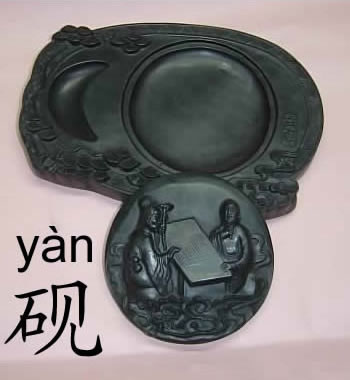Today we’ll come to learn about the “Four Treasures of the Study” for Chinese calligraphy and Chinese paintings. It is called 文房四宝(wen fang si bao) in Chinese characters, 文房wén fang means the study room for Chinese scholars at their houses, and 四宝 sì bǎo refer to the four treasures or the tools they use to write and paint in their traditional culture.
The FOUR treasures are:
— 纸 zhǐ, paper
— 笔 bǐ, writing brush
— 墨 mò, ink stick
— 砚 yàn, inkstone
The “four treasures of the study” are a brush pen, an inkstick, paper, and an inkstone because they are indispensable to any traditional Chinese scholar. These four tools can also be used by the Chinese painter or calligrapher to create the beauty of Chinese art. As a result, much importance has been attached to the “four treasures of the study.”

– Writing Brush 笔
Among the various tools of calligraphy, the writing brush is special to China. While brushes are varied, the white goat hair, black rabbit hair and yellow weasel hair brushes are the three major types. On the basis of function, they are classified into three groups: “hard,” “soft” and “both.” The brush handle can be made of either bamboo, wood, lacquer or porcelain; precious materials, such as a mother-of-pearl inlay, ivory and jade, can also be used.
The writing brush has a long history: prehistoric painted pottery, inscriptions on oracle bones, bamboo slips and silks all served as its writing materials. Some ancient writing brushes were excavated in graves of the Spring & Autumn and the Warring States periods (770-221BC) and the Qin and Han dynasties (221BC-AD220). In the Tang and Song dynasties (618-1279), Xuanzhou became the national writing-brush production center where Xuan-bi and Zhuge-bi were of the best quality. After the Yuan Dynasty (1271-1368) the brush-producing industry of Huzhou boomed and Hu-bi replaced Xuan-bi. The Hu-bi was sharp, neat, round and tough.

– Ink stick 墨
The ink stick is the unique pigment used for Chinese traditional painting and calligraphy. Initially, stage natural ink or half-natural ink was generally used. It was during the Han Dynasty (206BC-AD220) that artificial ink appeared. At that time the most famous ink stick was Yumi-mo, which was produced at Qianyang in Shaanxi. The raw materials of the ink stick were pine, oil and lacquer.
Before the Five Dynasties (907-960) the ink-producing center was located in the North; then, it reached the South. The most celebrated southern ink stick was Hui-mo, which was produced in Huizhou of today’s Anhui Province.

– Paper 纸
Paper is one of the most famous Chinese inventions. It is widely believed that paper was invented by Cai Lun in the Eastern Han Dynasty (25-220). However, archaeologists have discovered paper samples in the Western Han Dynasty (206BC-AD8), such as Fang-ma-tan, Ba-quao, Xuan-quan, Ma-quan-wan, Ju-yan and Han-tan-po paper.
In the Tang and Song dynasties, the paper-producing industry was thriving and top-quality products appeared in succession. During the Qing Dyansty (1644-1911) Xuan-zhi, which was produced in Jing Prefecture of Xuanzhou (Anhui Province), became the special paper for painting and calligraphy; it was regarded “the king of paper.”

– Inkstone 砚
Inkstone is the most important of the “four treasures of study.” Because of its solid texture inkstone can be handed down from generation to generation.
In the ruins of primitive society, archaeologists discovered simple stone ink slabs that required a pestle to grind pigments. After artificial ink sticks appeared in the Han Dynasty, pestle gradually disappeared. In the Han there were pottery, lacquer and copper ink slabs, as well as stone ink slab. Among the stone ink slabs, the round tripod pieces were most common. During the Wei, Jin and Northern and Southern dynasties (220-581), round tripod porcelain ink slabs were in vogue. It was in the Sui and Tang dynasties (581-907) that Piyong inkstone with circular legs appeared.

– Others
Apart from brushes, ink sticks, paper and inkstone, ancient calligraphy tools also included accessories, such as penholders, brush pots, ink boxes, paperweights, seals and seal boxes. The raw materials of such tools was pottery, porcelain, copper, iron, lacquer, wood, bamboo, stone, jade, jadeite, agate and coral.